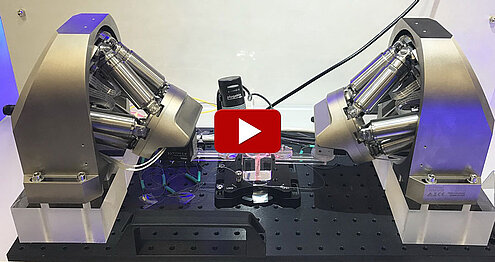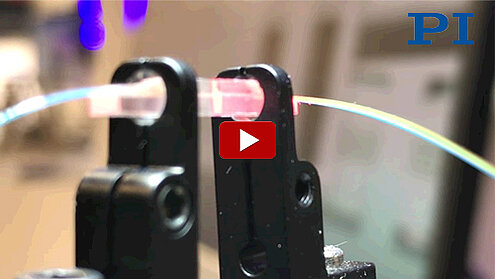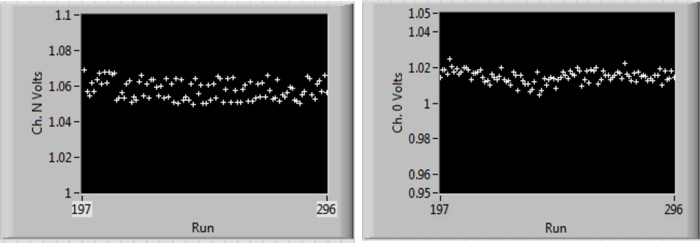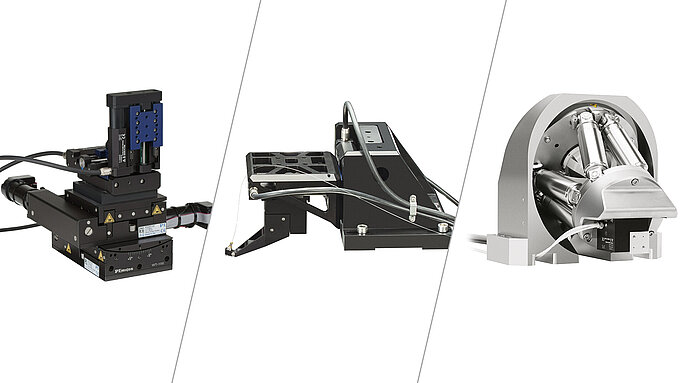In der Siliziumphotonik (SiP) geht es heute um mehr Kanäle, kleinere Formfaktoren und exponentiell höhere Produktionsmengen als im ersten Telekomboom vor zwei Jahrzehnten. In Querrichtung liegen die Toleranzen in der Ausrichtung deutlich unter 50 Nanometern. Mehrkanalige Ein- und Ausgänge erfordern mindestens eine zusätzliche Theta-Z-Ausrichtung, um die Kopplungen über das Eingangs- oder Ausgangsarray zu optimieren und auszugleichen. Häufig muss auch die Theta-X- und Theta-Y-Orientierungen optimiert werden, und die Z-Abstände eingestellt werden.
Traditionell wird ein iterativer Ansatz verfolgt, um eine globale Optimierung aller Freiheitsgrade zu erreichen - ein sehr zeitaufwändiger Prozess.
Die Lösung von PI setzt dagegen auf parallele Optimierung. Die schnellen Mehrkanal-Faserpositioniersysteme (Fast Multichannel Photonics Alignment Systems, FMPA) integrieren neuartige, firmware-basierte Algorithmen, die es ermöglichen, mehrere lineare und winklige digitale Gradienten-Suchausrichtungen gleichzeitig und parallel durchzuführen.
Mit FMPA kann eine globale Optimierung über alle Eingänge, Ausgänge und Freiheitsgrade auf einen einzigen schnellen Schritt reduziert werden. Durchsatzverbesserungen des Ausrichtungsprozesses von mehr als 1 bis 2 Größenordnungen sind im Vergleich zu früheren Ausrichttechnologien üblich.
Und diese Verbesserungen greifen nicht nur in der Produktion, Charakterisierung, Test und Inspektion von mehrkanaligen Siliziumphotonik Elementen, sondern sie finden auch Anwendung bei LIDAR Sensoren, bei der Montage von Smartphonekameras und zunehmend für quantenoptische Bausteine.
>> Lesen Sie den vollständigen Blogartikel in englischer Sprache
PI continued with its tradition of addressing a challenging application on the conference floor at 2017’s teeming Photonics West. Spotlighted in the booth was a head-turning array alignment application that deployed a six-degree-of-freedom H-811 hexapod and a P-616 Nanocube to align two fiber arrays.
The key to this application was the parallel execution of angular and transverse alignments. The Nanocube performed a transverse gradient search with tracking to lock-onto the first channel of the array, while the hexapod performed a theta-Z gradient search on the Nth channel of the array. The hexapod’s commandable pivot point allowed the rotational centerpoint to be placed very close the optical axis of the first array element. The Nanocube’s XY lock-on compensated for the small residual transverse runout due to imperfections in localizing the optical axis.
The system then went about its business of repetitively de-aligning and re-aligning the array as attendees watched. The whole process only took a few seconds, including delays inserted to assist visualization. Animating the process was a user-friendly, scriptable GUI constructed from PI’s extensive software libraries, which provide cross-platform support of many popular programming languages. A test executive was then constructed in Python to automate the operation of the GUI (MATLAB has also been popular for this), allowing many thousands of faultless alignments to be performed for visitors to the booth.

A Unique, Fab-Class Architecture
FMPA is based on 100% closed loop digital technology, virtually eliminating drift when not tracking. Besides the parallel gradient search capability, the controller firmware includes rapid areal scanning with automatic fitting for centroid determination, allowing fast, robust alignment of challenging couplings like top-hats.
FMPA systems are based on a 100x100x100µm travel compact XYZ “Nanocube” nanopositioner, offering 25X the capture area of typical alignment hardware. In most applications, the Nanocubes are mounted on high-performance long-travel stages or on compact, high-resolution 6-degree-of-freedom hexapods, depending on whether or not the devices being aligned require angular optimization.

An Industry Enabler
FMPA is a uniquely fast, capable, flexible, and precise architecture that has been deployed throughout the SiP production chain, from wafer test to packaging automation and intermediate chip-level tests. Its unique, firmware-based parallel capabilities enable one-step global optimization across multiple channels and degrees of freedom, representing a truly enabling technology that can speed time-to-market and ensure the profitable manufacture of silicon photonics devices.
New Applications
A recent paper on >> Monolithic mode-selective few-mode multicore fiber multiplexers by N. Riesen et al from The Institute for Photonics and Advanced Sensing (IPAS) and School of Physical Sciences, Adelaide, Australia) describes a technique to increase the bandwidth of fiber networks by space-division multiplexing. There are different solutions including mode division multiplexing and the use of multicore fibers. Parallel alignment engines such as the above described FMPA system can be of great value to speed up the move of these new techniques from the lab to the field.




